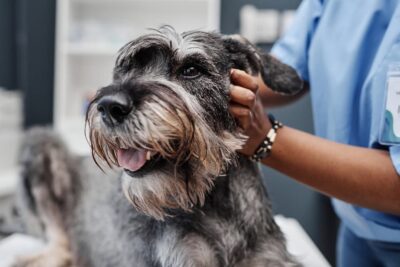Dog Eye Stye: Symptoms and Treatment Options

Overview
If you or a family member have ever experienced a stye, you are probably familiar with the pain and discomfort that these lesions can cause in people. You may not be aware, however, that this same problem can also affect our canine companions.
Fortunately, dogs probably don’t experience the same degree of self-consciousness that we do when suffering from a stye. They aren’t embarrassed to be seen in public with a stye, like some humans might be. Aside from that one key difference, dog eye styes affect our four-legged friends just like they affect us.
What Is an Eye Stye?

An eye stye in dogs, also known as a hordeolum, is a painful red bump that forms along the edge of a dog’s eyelid. It occurs when oil glands in the eyelid become impacted and infected, similar to a pimple.
Styes occur in dogs, humans, and other species. The appearance of a stye on a dog’s eye is relatively similar to their appearance in humans. However, the fur on a dog’s eyelid can mask a stye, making it difficult to see until it has become dramatically enlarged or is causing the dog obvious discomfort.
How Do Dogs Get Styes in Their Eyes?

In most cases, a stye occurs when the oil gland becomes infected with the bacterium Staphylococcus aureus. This infection can come on quickly, and styes can be very painful.
We often don’t know what causes a particular dog to develop a stye. Some cases are associated with a weakened immune system or a history of eye trauma, but many cases have no known underlying cause. Anything that causes swelling and irritation of the eyelids could potentially predispose a dog to styes, including environmental allergies, substances applied to the eye, or hair or debris that is trapped around the eyes.
Styes can occur on the upper or lower eyelid. They can affect any breed of dog, and any age of dog.
Diagnosing Dog Eye Styes

If you suspect that your dog may have a stye, begin by scheduling a consultation with your veterinarian. Your veterinarian will need to perform a physical examination, in order to determine whether your dog has a stye or some other condition affecting the eyelid. For example, older dogs are often prone to benign tumors of the eyelid as they age, and these require specific treatment. In some cases, even autoimmune diseases can look like a stye in their early stages.
There are some basic home care steps that you can take, until you are able to get your dog in to see a veterinarian.
Keep your dog’s eyes clean. Use a warm, moist washcloth to gently wipe debris away from the eyelids. Take care to avoid scratching the surface of your dog’s eye.
Apply a warm compress. If your dog will remain still and allow you to apply a warm compress to the eye, this can help encourage the stye to rupture. When the stye ruptures, you may see a small amount of pus come to the surface of the eyelid.
Clean away pus. Carefully clean this pus away, to prevent the infection from spreading. In many cases, the rupture of a stye provides immediate relief from pain and discomfort.
When you see your veterinarian, they will perform a thorough physical examination, with special attention given to your dog’s eye. The veterinarian will look carefully at the suspected stye, as well as the other structures of the eye. They will assess whether the swelling on your dog’s eyelid is painful, as this is a key method of distinguishing a stye from some other common eyelid lesions.
If your dog’s eye is red and inflamed, your veterinarian may also recommend additional tests to rule out conditions such as a corneal ulcer, dry eye, or glaucoma. If the eye itself is healthy and the swelling appears to be consistent with a stye, your veterinarian will likely recommend medical treatment.
How to Treat a Dog Eye Stye

Dog eye stye treatment relies primarily on antibiotics, although anti-inflammatory medications may also be used to alleviate discomfort.
Your veterinarian may prescribe a topical eye ointment that contains both an antibiotic and a steroid, such as Neo/Poly/Dex (Neomycin Polymyxin Dexamethasone) Ophthalmic Ointment or Ophthalmic Suspension (drops). This medication will be absorbed from the surface of the eye into the eyelid, treating both infection and inflammation. Less commonly, your veterinarian may prescribe oral antibiotics, such as cephalexin and cefpodoxime, and/or anti-inflammatory medications like carprofen. Oral medications may be preferred in dogs that resent having their face or eyes handled.
Regardless of which treatment is prescribed, be sure to give all medications as directed. Completing the entire course of treatment is essential to ensure the best possible outcome. Attend any rechecks as recommended by your veterinarian, to ensure that the stye has fully resolved and no further treatment is needed.
If your dog has a severe stye that does not respond to medical treatment, your veterinarian may recommend surgery. Your dog will be anesthetized, and your veterinarian will surgically drain pus from the infected gland. In some cases, your veterinarian may recommend more aggressive surgery, removing a wedge-shaped region of the affected eyelid margin. This not only maximizes the likelihood of curing a stye, but also allows your veterinarian to submit the removed tissue to a pathologist for microscopic examination. A pathologist can then definitively distinguish whether the lesion is a stye or some other type of eyelid lesion. After surgery, your dog may be sent home with medications, as well as an Elizabethan collar (e-collar or cone), like the Buster Comfort Collar, to prevent self-trauma of the eye and eyelids.
General Cost to Treat Dog Stye Eye
Fortunately, most cases of dog eye styes are treated more conservatively, as noted above. However, there are times when a severe stye may require further intervention. Surgery isn’t always necessary, but on occasion, a stye will not resolve with medications alone.
It helps to plan ahead for any medical costs your dog may incur. Here’s a breakdown of some of the general costs to treat dog stye eye:
| Anti-inflammatory medication | $15-$60 |
| Blood panel | $100-$300 |
| Examination by a regular veterinarian | $45-$85 |
| Examination by an ophthalmologist | $200-$400 |
| Oral antibiotics | $20-$50 |
| Prescription topical eye ointment | $20-$50 |
| Surgery to remove the stye | $300-$1,000 |
The costs associated with stye treatment in dogs aren’t incredibly expensive, but each treatment, procedure, or surgery adds up. A pet health insurance policy can help pet parents manage these costs by offsetting veterinary expenses that come with unexpected illnesses and accidents.
How to Prevent Styes on Dogs

There is no guaranteed way to prevent dog eye styes.
If your dog is prone to styes, your veterinarian may recommend regularly cleaning your dog’s face and eyes to reduce the buildup of dirt and debris.
If you notice evidence of a stye, or any other condition affecting your dog’s eyelids, seek veterinary care as soon as possible. An untreated stye is not only painful, its swelling can affect the surface of the eye itself, leading to corneal damage that could potentially affect your dog’s vision. Early diagnosis and treatment of styes is the best way to minimize their impact.









